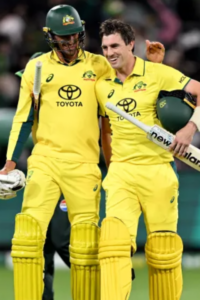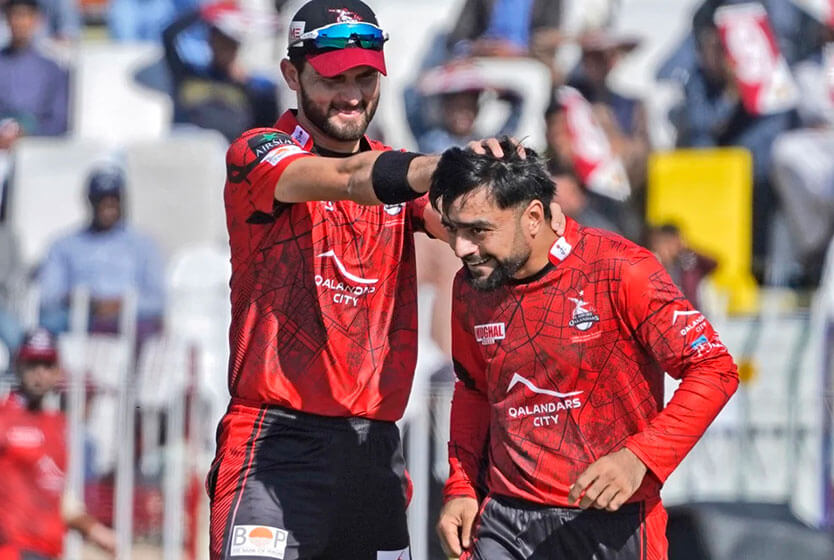
The Mirage of the Aggressive Opener(s)
Pakistan cricket fans want more aggressive openers in T20Is. But do they have the players to play those roles?
Watching the likes of Jason Roy and Jos Buttler opening the batting and smashing bowling attacks to all parts of the ground made Pakistani fans green with envy in the recently concluded T20I series against England. Well, up next are the West Indies – the team with the highest powerplay run rate in T20Is since 2020.
It’s very much a sign of the evolution of the T20 format that teams are shifting toward ultra-attacking batting lineups, sometimes with no anchors whatsoever in the team – which could be the ultimate objective for the T20 format. However, this undoubtedly depends on the available resources. Pakistan is currently one of the only T20 teams relying on essentially a dual-anchor setup at the top. Do they have the means to opt for more attacking alternatives? Let’s investigate.
The Powerplay Problem
In the early years of T20 cricket, Pakistan were among the pioneers in the format. Shahid Afridi was born to play T20 cricket. Umar Gul remains the bowler with the highest ever rating in the T20 format for bowlers, nailing yorkers with surgical precision in his prime. Saeed Ajmal was one of the few spinners to bowl at the death in T20’s early years – with ridiculous success.
When it came to the powerplay, though, Pakistan were like the rest of the teams in the early years of T20. They usually focused on laying a solid base. Before 2012, Sri Lanka and Australia were the only teams with a powerplay run rate in excess of 8 – just about. Pakistan hovered around 7.5. Since the 2016 T20 World Cup, all the major sides are now scoring at 8+ in the powerplay. Pakistan are still hovering at around 7.5.
| Team | Before 2012 | Since T20 WC 2016 | Since Dec 2020 |
| Australia | 8.1 | 8.8 | 8.6 |
| England | 7.8 | 8.7 | 8.8 |
| India | 7.6 | 8.3 | 6.7 |
| New Zealand | 7.3 | 8.3 | 8.2 |
| South Africa | 7.3 | 8.2 | 8.7 |
| West Indies | 7.2 | 8.2 | 9.6 |
| Sri Lanka | 8.2 | 8.1 | 6.3 |
| Pakistan | 7.4 | 7.4 | 7.5 |
While the rest of the world has moved on, Pakistan first dropped off between 2012-16 and are now back to where they were ten years ago. Even with Mohammad Rizwan opening the batting since December 2020, the scoring rate in the powerplay hasn’t changed much.
The Responsible Personnel
Pakistani Batsmen in T20I Powerplay Overs (1-6) Since 2016 T20 World Cup
| Batsman | Avg | SR | BPB | Runs |
| Babar Azam | 47.6 | 125.2 | 5.3 | 761 |
| Fakhar Zaman | 26.2 | 132.8 | 4.9 | 628 |
| Mohammad Rizwan | 59.3 | 121.1 | 5.4 | 356 |
| Ahmed Shehzad | 44.8 | 110.9 | 6.1 | 224 |
| Haider Ali | 22.6 | 131.4 | 5.1 | 113 |
| Hussain Talat | 53.0 | 112.8 | 6.3 | 106 |
| Sharjeel Khan | 19.6 | 118.1 | 4.6 | 98 |
| Mohammad Hafeez | 23.5 | 87.0 | 7.2 | 94 |
| Khalid Latif | 75.0 | 110.3 | 5.7 | 75 |
A lot of batsmen have come and gone, with Babar Azam usually being the one constant. Fakhar Zaman’s figures look decent – until you divide them into pre and post-2019. Before 2019, he averaged 35 @ 140 in powerplays, being the ideal sort of opener to complement Babar. His output, however, dropped off a cliff after 2019, with both the average and strike rate taking a 20-point hit.
The other options explain just why Pakistan have struggled to gain momentum in the opening overs of their batting innings. Barring a couple of innings of note from Haider Ali, there is precious little to boast of.
Babar Azam and Mohammad Rizwan
In a very short period, this partnership has become Pakistan’s most successful in T20I cricket. The two openers have already put on two stands of 150+ against South Africa and England. However, the fact remains that they are rarely fast to start in the powerplay. Rather, they build a base and then capitalize on it once set – not quite the prototype followed by some of the more attacking batting sides.
Most Runs By Pakistani Opening Pairs
| Partners | Inns | Runs | Ave | RR |
| Babar Azam, Mohammad Rizwan | 10 | 521 | 52.1 | 9.2 |
| Babar Azam, Fakhar Zaman | 19 | 489 | 25.7 | 8.0 |
| Imran Nazir, Mohammad Hafeez | 12 | 385 | 32.1 | 7.8 |
| Ahmed Shehzad, Fakhar Zaman | 9 | 367 | 40.8 | 8.1 |
| Kamran Akmal, Salman Butt | 9 | 321 | 35.7 | 8.1 |
The Alternatives
The narrative that is common in the cricketing sphere is that Pakistan would be better off utilizing more ‘aggressive’ batsmen in the powerplay. The two names that always pop up are Fakhar Zaman and Sharjeel Khan. This suggestion is based on an idea rather than reality – an idea that says that the two left-handers are powerplay aggressors.
Pakistani Batsmen in T20 Powerplays (1-6) Since 2019 (Min 400 Runs)
| Batsman | Avg | SR | BPB | Runs | SR vs. Pace | SR vs. Spin |
| Kamran Akmal | 25.6 | 133.0 | 4.3 | 794 | 124 | 189 |
| Babar Azam | 46.5 | 125.5 | 5.3 | 1535 | 128 | 114 |
| Mohammad Rizwan | 56.4 | 123.7 | 5.1 | 846 | 120 | 143 |
| Fakhar Zaman | 29.5 | 121.6 | 5.3 | 1150 | 119 | 137 |
| Imam-ul-Haq | 26.0 | 119.8 | 6.3 | 520 | 118 | 129 |
| Sharjeel Khan | 18.6 | 119.3 | 5.2 | 483 | 119 | 119 |
| Shan Masood | 25.9 | 108.4 | 7.1 | 415 | 103 | 130 |
Kamran Akmal has the best powerplay SR of the lot. However, he relies rather heavily on his spin-hitting ability. Fakhar Zaman, in recent years, has sacrificed some of his attacking tendencies in the powerplay, focusing on the long game. Sharjeel Khan, meanwhile, has struggled immensely in powerplays since his comeback. He rarely capitalizes on the powerplay, also being very susceptible to pacers, left-armers in particular.
Thus, that idea of the aggressive left-handed openers turns out to be a mirage once you get closer to reality. There’s a reason why PSL sides like Islamabad United opt for overseas openers and top order aggressors. The truth is that there are no strong candidates in Pakistan at the moment.
Pakistan’s Current Team Composition
Let’s be clear: Having two anchors at the top of the order isn’t ideal for any T20 side. However, having two batsmen with lower SRs who also get out more often is even worse if you have a misfiring batting lineup. Additionally, it’s important to take stock of Pakistan’s batting issues and see the opening partnership in that context.
Babar Azam’s side has been struggling with the middle order for quite a while. The personnel options for pace hitters in the lower order are few and far between. The nature of being middle-order attackers also means that the success rate of these batsmen will be naturally low. It also doesn’t help that the management often makes basic tactical errors. All these combined factors mean that Pakistan is currently struggling to formulate an effective batting lineup.
Thus, the best way for Pakistan to currently maximize resources is to opt for an attacking middle-order lineup with the anchors at the top. This may include the likes of Sohaib Maqsood, Haider Ali, Azam Khan, Fakhar Zaman, Mohammad Hafeez, etc.
Intent Importance
Even if Pakistan aren’t able to get to the level of some of the other top sides when it comes to batting powerplays, they can look to close the gap. This undoubtedly requires the right type of intent from the openers. Rizwan often takes five or so deliveries to properly get an idea of the surface but shows good scoring intent after that.
For Babar, the potential is perhaps higher than Rizwan’s due to his natural shot-making ability. The T20I series against England was very interesting to watch for this reason. In the first T20I, Babar opened up after the first couple of overs and played some shots that we’re not used to seeing from him. For example, the shuffle down the pitch against David Willey, glancing the ball for a boundary.
In the last T20I, many were alarmed to see Babar losing his shape as he struggled to 11 off 13. However, what was interesting to see was his intent as he went after the bowlers in an unorthodox manner. It’s a different matter that Pakistan appeared to have misread the pitch and were perhaps aiming for more than what was needed. Once he can finetune his intent and get used to batting a bit more aggressively in the powerplay, perhaps sacrificing a bit of consistency for a better scoring rate, the sky is the limit.
Long-Term Prospects
Young Pakistani opening batsmen hoping to make an impact in T20 cricket and potentially make a career for themselves in this format should see this as an opportunity. However, the fact is that developing such players is not easy. First, you need a robust grassroots system so that batsmen have strong fundamentals of their game. Then, you need to develop a certain type of mindset at the domestic level that encourages this type of performance.
This is where the likes of England and India have done so well. Investment in infrastructure is a massively fruitful long-term decision that is likely to pay off. For a young Pakistani batsman looking to make a similar impact, there will be many obstacles, and it won’t be easy. But as is the case with all things, Pakistan will eventually get there as well. Let’s hope that it’s sooner rather than later.
For now, that mirage of the aggressive opener will remain in the minds of many. However, the numbers speak for themselves.







Leave a Reply